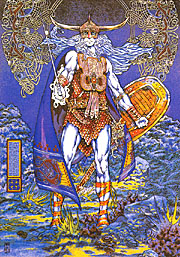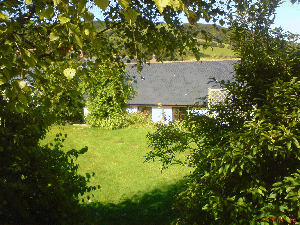
Lugh by Joanna Powell Colbert
(Part 1 is here) (Part 2 is here)
Cernunnos and Lugus/Lúgh: What is the Relationship?
So how do these two gods relate to each other? Rather tantalisingly Alexei suspects that the answer lies in a now-vanished element of Gaulish mythology. But looking to the later insular literature, he notes that Manannán is Lúgh’s foster-father and in the Welsh Mabinogi, Gwydion is Lleu’s foster-father and says that if we observe that “both characters are older versions of the young hero in their talents and attributes, and indeed very “Mercury”-like [the Celtic Mercury which he equates with Lugus] – we may indeed come very close to understanding the nature of the relation.”
(As an aside, note that in the third branch of the Mabinogi there is another nature versus culture myth. But this time it is Manawyddan fab Llyr, who is related to the Irish Manannán, who takes on the role of the character who defeats the malign powers of the Otherworld, an army of mice who eat the crops, and he uses trickery to defeat them and restore the Land for the tribe.)
Now I am not very sure what understanding Alexei thinks we may come to by considering these older versions of the young hero. Possibly it relates to my own speculation - that, of ‘the Old Gods’, Cernunnos is a Very Old God, a kind of precurser to Lúgh from the age of the hunter.
Consider the rock carvings at Val Camonica which give us the earliest depiction of an antlered god in a Celtic context. These petroglyphs are amazing in that they span a period of about 8,000 years and show a development of ideas through the different ages. The earliest carvings, well before the rise of the Celts, are from the Mesolithic period (8th –6th millenium BC) and were made by nomadic hunters. They depict their prey - typically deer and elk.
In the Neolithic period, with the beginning of agriculture (5th – 4th millennium BC), human figures and geometric patterns, rectangles and circles among others, appear, giving perhaps the idea of fixed settlements. By the Bronze Age, roughly the 2nd millennium BC, weapons began to appear, along with the geometric shapes, and in the Iron Age (1st millennium BC), where our first depiction of ‘Cernunnos’ comes from, the Camunni people carved symbols of “heroic masculinity and superiority. Dominant themes include representations of duels and human figures…flaunting their weapons, their muscles and their genitals. There are also figures of cabins, labyrinths, footprints, hunting scenes and other symbols.” (Source: Wikipedia)
The point I want to make here is that humankind’s relationship with stags goes far, far back into the Mesolithic age when they were hugely important as prey. It's true that it wasn’t until the Iron Age at Val Camonica that a depiction of a hybrid stag/human appeared but the interaction of human and stag was a vital one going back into human prehistory and humans were hunters before we were farmers. Therefore it would not be surprising if one of the early Celtic gods, perhaps inherited from the pre-Celtic tribes, was of the stag/human form and related to food/fertility/hunter/hunted/the wild/ the human.
The authenticity of the antlers on the human/animal figure known as “The Sorcerer” from the cave of the Trois Frères in the French Pyrénées (much later to become a Celtic region) and dated to the Palaeolithic age (c. 13,000 BC) is the subject of some dispute although it now seems to be vouched for. (See here - and read right to the end for additional comments.) If indeed authentic it illustrates what I'm suggesting here. We don't know of course what it represents, if it's a god or a shaman or something else, but it does show, I would argue, the importance of the relationship between human and stag.
In the Le Tène period, starting around 500 BC, there was an expansion of the Celtic tribes, an accumulation of wealth and territory, and, according to Alexei, this period gave rise to depictions of a god, (often with mistletoe leaves around his head like horns or ears) whom Alexei identifies with Lugus. This god appears in the Roman period as a Celtic “Mercury” and Julius Caesar writes in his Gallic Wars (Book 6, 17):
“They worship as their divinity, Mercury in particular, and have many images of him, and regard him as the inventor of all arts, they consider him the guide of their journeys and marches, and believe him to have great influence over the acquisition of gain and mercantile transactions.”
However native depictions of him show certain other traits as well, namely triple forms, and a role as sovereign protector with warrior attributes. (See Lugus: The Many-Gifted Lord)
Going back to the Val Camonica carvings, we can see the development of human organisation and values and the increasing importance of weapons, male virility, and conflict. It makes sense to me that ideas about the way to obtain the fruits of the wild evolved from a hunter/hunted model - at a time when humans had less effective weapons to defend themselves and when they may have facilitated the exchange of goods and services through reciprocal gift exchange as Mauss outlines – to a model of wresting food from nature by conflict and manipulation as they moved into agriculture and a martial, warrior-centred state of organisation which used trade and the money economy as its form of exchange of goods and services.
Because of the huge importance of the Cernunnos-type god, it would not be surprising that he existed side by side with another, more recently popular god who embodied the current concerns and values of an agricultural, warrior élite; a god whom we see echoed in the warrior Lúgh in the Cath Maige Tuired.
Lugus/ Lúgh
In some ways we could say that Lúgh combines in himself the attributes of the antlered god and the horned god, as a powerful fighter and protector of the food resources of the tribe. Certainly many modern illustrations show him horned by virtue of his helmet, such as this…

'The Coming of Lugh the Il-Dana', © 1979, Jim Fitzpatrick
But he is, of course, more than simply a warrior god and the illustration at the top of this post gives a better idea of the way he combines attributes as a deity of the arts and intellectual skills, music and poetry; an associate of ravens as well as the owner of the spear, a practitioner of magic and champion of the harvest.
The Reconciliation of Opposites
I said earlier that being part Fomorian, part Tuatha Dé Danann, Lúgh is in a sense fighting against himself. Because of Cernunnos’ dual nature as stag/human, the same may be said of him. He is both hunter and hunted; the human hunting the stag and the stag being hunted. Both parts of these gods are in opposition to each other and, to avoid annihilation or perpetual conflict, must find a way of accomodating one another. They both must become a reconciler of opposites in order to keep these opposing forces in balance. How do they do this? I believe it is by negotiation and reciprocity. In the story of Lúgh and Bres, they negotiate so that in the end Lúgh does not harm Bres but exchanges his life for knowledge of how to improve the harvest and therefore the lives of the Tuatha Dé Danann.
We don’t know how Cernunnos has gained power over the ram-horned snake, who like Bres and the Fomóirí represents the powers of the Land, benign and malign. It is possible that he promises not to kill the snake in return for access to the fruits of the nature. In the end, some sort of quid pro quo, some exchange of goods or services must have been enacted – if only an exchange of mutual respect for the spiritual source of each other's honour and power. In this way, disaster is averted. Wild nature and the human world are kept in a healthy balance.
However, by the nineteenth century, when Western society began to become more industrialised, I think we began to lose contact with the meaning of these gods.
Taking the folktale of Donnchadh Mór (which I wrote about in Part 2) as an example, we can see by the ending that the essential truth of Lúgh’s story has been lost. Donnchadh should have married the Cailleach’s daughter, representing the benign power of the Land, who helped him, and together they could have kept in check the malign powers of the Cailleach. Instead mother and daughter die and the hero is seen as the winner, the conquerer.
It’s easy to see why this is so. In the 19th century the success of the harvest was crucial but still uncertain. Yet humankind was beginning to develop, with a Lúgh-like ingenuity and skill, more effective means to secure it. Humans were beginning to control and tame wild nature.
But now, by the 21st century, we have moved on from there. In ancient times Tailtiu could be praised and celebrated for clearing the forests to make plains for agriculture; now we have lost too much of our forests and need to plant them again, since lack of them is having a negative effect on the suitability of the environment for humans. Nature has been tamed to the extent that now the fertility of the land is being compromised.
What we have forgotten is that, like Cernunnos and Lúgh, we too have a dual nature: like Cernunnos we are human and animal (mammal), we were once hunter and hunter, now, perhaps, in the almost complete absence of natural predators, we are preying on each other. Like Lúgh we are both beings with social organisation and culture, needing sustenance from the Land, and we are a part of nature, with its benevolence and its cruelty. We cannot harm one without harming the other, part of ourselves.
Alexei concludes his article on Lúgh with this statement:
"Even today, the spirit of Lúgh pervades the Celtic world… Trickster, psychopomp, experimenter, mover between worlds, granter of success and wealth through intelligent manipulation, and granter of continuity through change, his many gifts remain at the disposal of those who trouble to seek him out."
I can’t help thinking that this spirit pervades more than the Celtic world. Trickster, experimenter, granter of wealth through intelligent manipulation – couldn’t we apply these attributes to the practices of the world’s bankers which have led to the banking crisis?
Isn’t the desire to control and manipulate in the practice of agriculture on an industrial scale leading to an impoverishment of the Land? Unlike an organic style of agriculture which gives back to the land to ensure fertility – a sort of reciprocity – modern chemical fertilisers take from the Land and leave it depleted. We are following a model of taking in order to take rather than giving in order to be given to. Some of the practices of the huge multinational agribusinesses surely display the worst side of Lúgh’s attributes: control, conflict (aggressive litigation), genetic manipulation, the accumulation of wealth through the commercialisation of seeds.
Whereas for Lúgh, concern for and sacred duty to the well-being of the Tribe, the paramount importance of the fertility of the Land (a lack of which would undermine kings) and the value of honour would have provided a check on the negative side of his attributes - the dangers of an excess of them - we no longer have such checks.
If the gods rise and fall in prominence as human society and its values and concerns change, the value and relevance of Cernunnos and Lúgh have never been more essential. We need, I would argue, to balance conflict, skill and manipulation with the recognition that we need honour, respect and reciprocity in our dealings with Wild Nature – because it is our Other Self.









